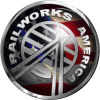To be honest, I totally ignore the track unevenness value when exporting track, as I don't find it to enhance the realism with invisible bad points built in to the track. I have built my own custom track lofts, and they are not that difficult to get working, provided that you are familiar with the 3d modeling at least.
For the line in question, You would be best off looking for a curve and gradient chart. These can be sourced through state government records, or similar.
With TS20XX, there isn't really a straightforward way to depict track in poor condition. You're best off placing weeds/debris over the right of way (ROW) if you want it to look rundown.
Whilst not highly important, it is recommended to have the track loft match the rail weight and gauge of the line in question. If you're modeling a major corridor, you don't want the track to resemble something from a 2ft gauge branch line. Scalerail (for standard/1435) gauge is reasonable to start with, or even the default Kuju track (this will require one less download for those who don't have the former).
I have not gotten the hang of speed signs yet so can't really help you there to be honest.
Regarding the gradients, these are critical. What I do with the gradient info I have (in .jpeg format) is be sure to have the chart sized so that each km or mile amounts to a power of 2, 4, 8 (or slightly higher) pixels in Irfanview (freeware image manipulation program) etc so that I can tell that say a 1.5 percent gradient goes for a km (when it amounts to 10 pixels when highlighting it in Irfanview). I try to lay the track incrementally in regards to the gradients, and I try to make sure that it is metre perfect. Although this sounds mundane, with a potential for a lack of realism, it gets the job done.
You will inevitably run into problems where you have laid the track seemingly flawlessly, and there is still an unwelcome gap between the track and the terrain. This is the point where you need to extend previous loft sections by say 30 metres when the gradient is downhill, and gradually work your way towards ground level whilst not making a major sacrifice with the realism of the route.
Remember that no matter how good a modeler is, this is only a video game, and nothing is 100% perfect, no matter who modeled it.
If you want more info about track laying, feel free to ask. ALWAYS remember to save your work every couple of minutes or so, and BACK IT UP externally! There is a video here that mentions how to create switches/points
https://www.youtube.com/watch?v=J6LPi_C7umw Hello all,
Hello all,

